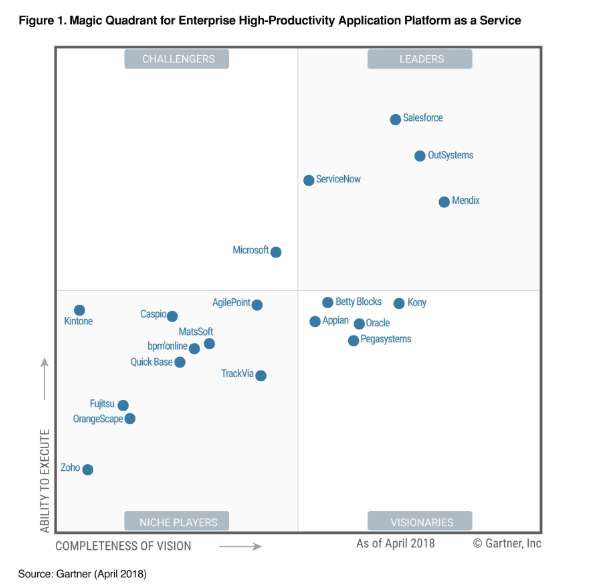"Technology has never been more important to organizations” –
Harvey Nash / KPMG CIO Survey 2018
“Low-Code Platforms enable rapid delivery of business applications with a minimum of hand-coding and minimal upfront investment in setup, training, and deployment.” - Forrester
- Do your legacy systems hamper your digitalization efforts?
- Does it feel like your competitors are gaining edge on innovation?
- Would you like to be able to deliver fully customer-centric solutions and do this faster than the competition?
- Does it take long to implement new technologies in your organization?
- Do you have a shortage of skilled software developers?
If you answered 'Yes' to these questions, maybe low-code platforms are for you. Read this overview and find out how low code can help address those challenges.
Most companies have put investments in technology-based innovation high on their strategic agenda. The current complexity of IT systems, a high effort required to process changes as well as the increasing cost of maintenance of IT systems and a lack of IT personnel impede innovation through software. The current wave of digital transformation faces them with quite some challenges. End users – either clients or employees – expect a seamless and connected user experience and businesses require faster delivery cycles to stay ahead of the game. Over the past decade though, the tooling for software development has evolved at a rapid pace providing an answer to the abovementioned needs. So called 'low-code platforms' have entered the market and have gained increased popularity since then.
What are 'low-code platforms'?
Low code was a term coined in 2014 by Forrester Research and it has quickly gained traction in the past few years. The low-code platforms, however, first emerged in the early 2010s as a response to the ever increasing pace of business application development and the evolution of programming languages.
Low-code platforms make use of a visual development approach to application development. With the use of low-code platforms software can be (re)built using model-based development, meaning that developers or even business analysts can create web and mobile applications, using modeldriven logic through a graphic user interface and making use of pre-built application components.
In general this means that, compared to traditional programming, a higher productivity rate can be achieved.
In this way low-code platforms enable rapid delivery of business applications with a minimum of development, as well as minimal upfront investment in setup, training and deployment. They are
offered as platform as a service (PaaS) and are intended for developing and delivering enterprise web and mobile applications, which run in the cloud, on-premises or in hybrid environments.
Solving the legacy problem
Research commissioned by Hitachi Consulting found that nine out of ten IT-decision makers think legacy systems curb their ability to grow and utilize the full potential digital technologies can offer.
Within the respondents, large companies were more likely to claim to be held back by legacy systems, with 44% saying it affects all or most projects, compared with 28% for medium-sized firms. The challenges for organizations, however, are not only to update legacy systems in order to harness the full benefit of digitalization, but also to go through their own digital transformation in order to stay relevant in an ever faster changing environment.
Whereas low-code platforms were formerly mainly used for mobile apps, workflow applications and niche software, they are now widely used for the renewal of business-critical legacy applications and software for core processes. This allows low code to form an integral part of an organization-wide digital transformation.
Digital transformation with low-code
In 2016, Forrester determined that using low-code platforms can produce applications six to twenty times faster, therefore enabling digital transformation even for small enterprises and for companies that did not start as 'IT shops'. Low-code platforms accelerate digital transformation by enabling rapid application development (some platforms, such as OutSystems, offer full-stack visual modeling capability and one-click deployments, which further accelerates development and eliminates the need for highly-skilled software developers). By offering full application lifecycle management, from design to deployment and maintenance, low-code platforms empower organizations to focus on customer experience and innovation, rather than application development and management.
The leaders in high-productivity platforms
According to the Gartner magic quadrant for Enterprise hpaPaaS, four low-code platforms are in the Leaders section – Salesforce, ServiceNow, Mendix and OutSystems.
OutSystems offers a comprehensive visual modeling capability, including business processes, integration workflows, UIs, business logic, data models, web services and APIs. These enable high-productivity development and a faster time to market for relatively advanced applications. The platform also includes many other services, such as project management and analytics. The Forrester Wave™ (2017) also places OutSystems in the Leaders quadrant for low-code platforms.








Top comments (0)